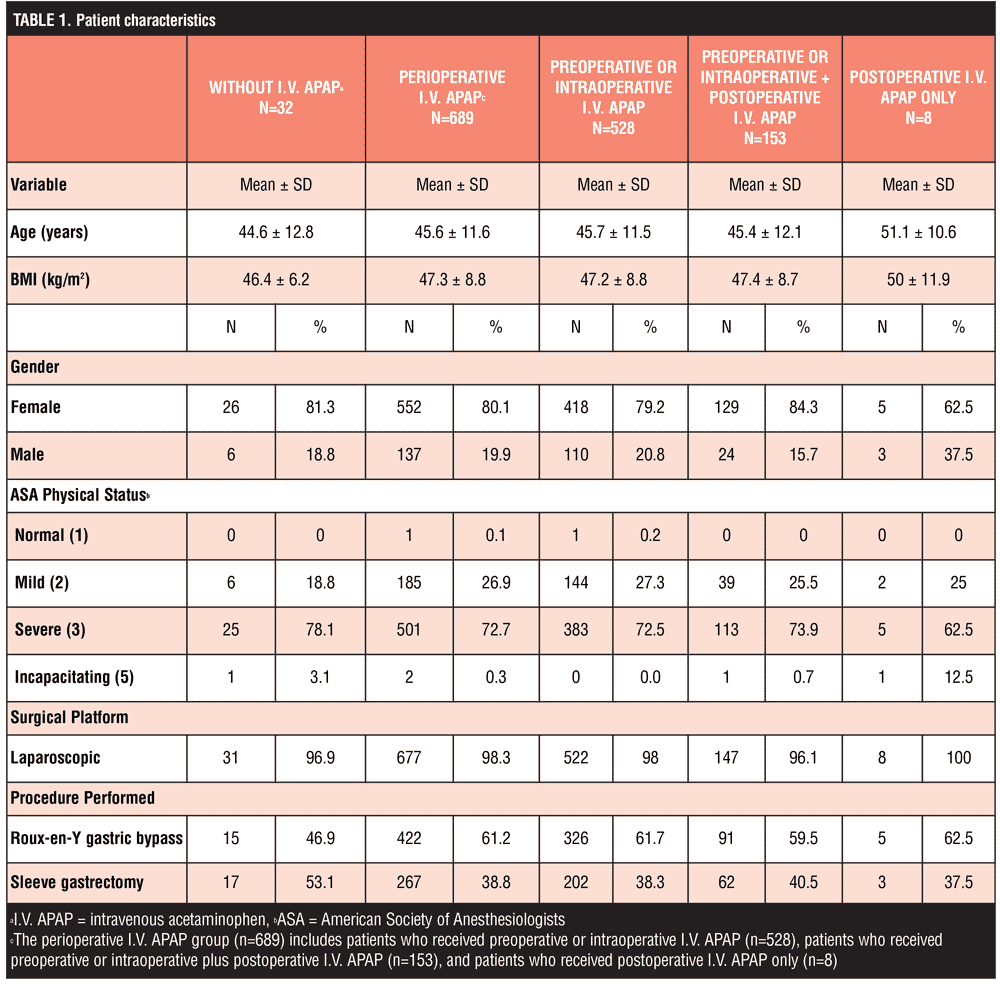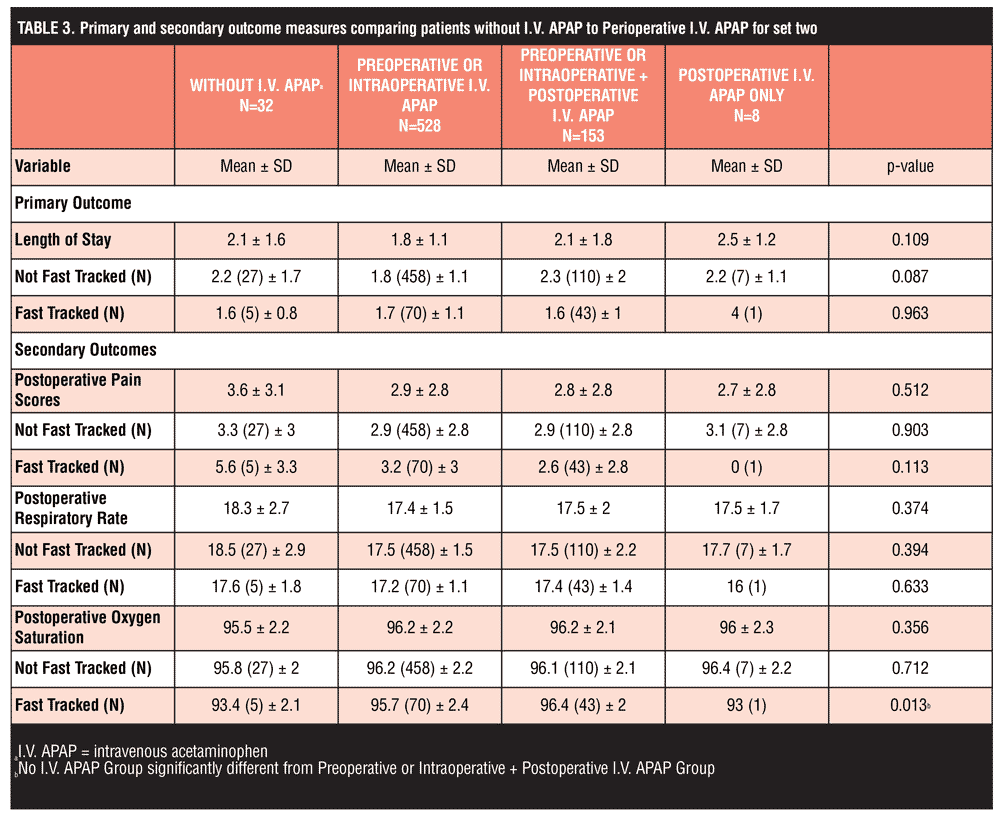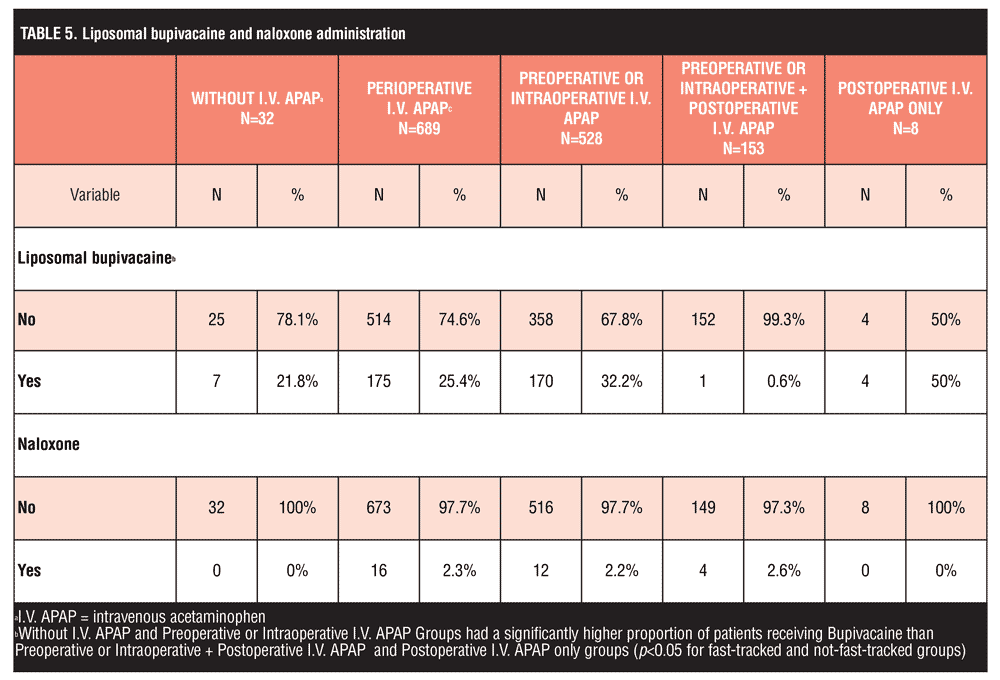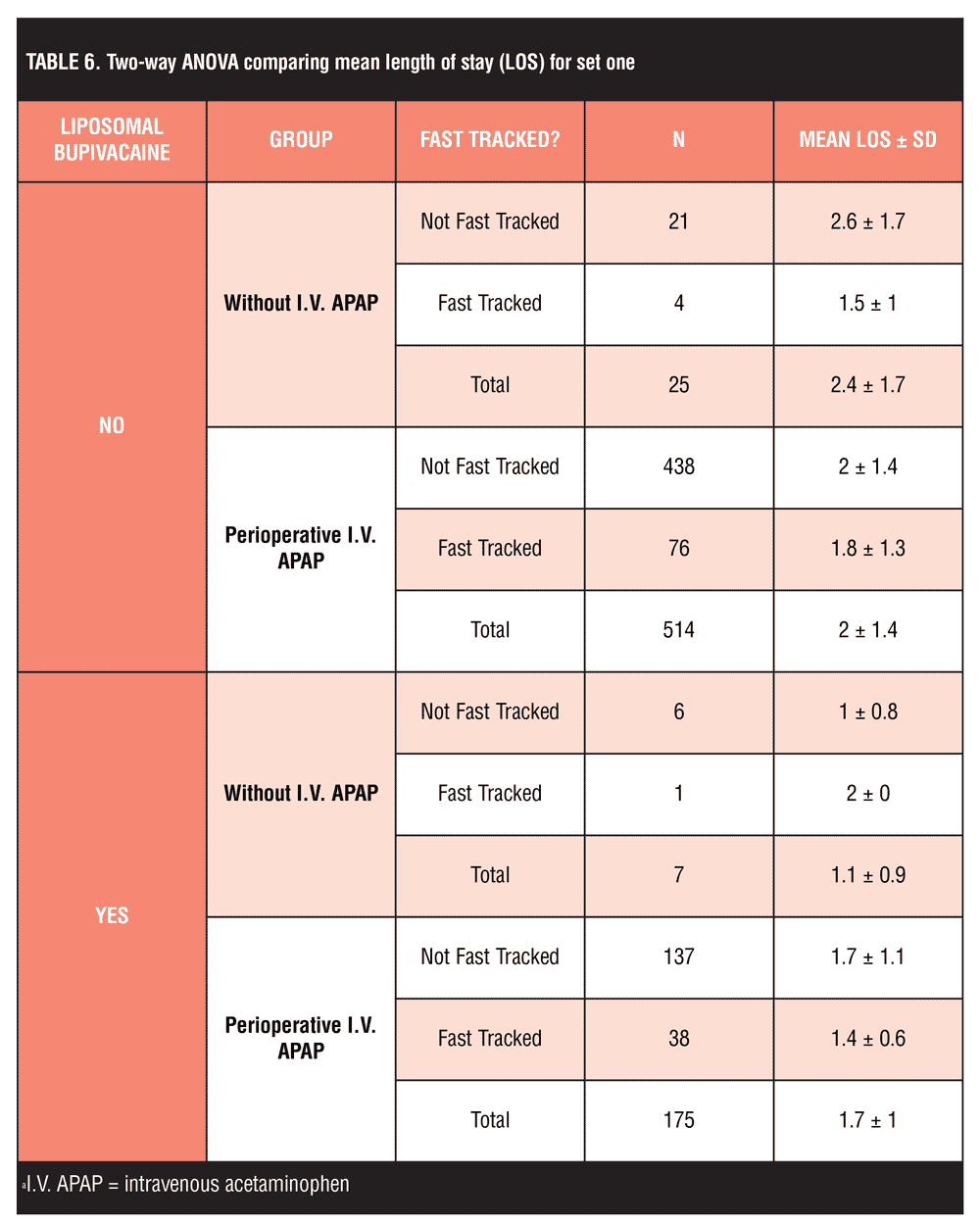A Single-center Retrospective Analysis of Intravenous Acetaminophen in Bariatric Surgery Patients
 by Kevin Cowart, PharmD, MPH, BCACP, Kathryn Crosby, PharmD, BCPS; Aranjeet Sidhu, PharmD; and Julie Thompson, PhD
by Kevin Cowart, PharmD, MPH, BCACP, Kathryn Crosby, PharmD, BCPS; Aranjeet Sidhu, PharmD; and Julie Thompson, PhD
Dr. Cowart is an Assistant Professor in the Department of Pharmacy Practice at Nova Southeastern University College of Pharmacy in Fort Lauderdale Florida. Dr. Crosby is a Clinical Pharmacist in the Department of Pharmacy at Duke Regional Hospital in Durham North Carolina. Dr. Sidhu is a Clinical Pharmacist in the Department of Pharmacy at Duke Regional Hospital in Durham North Carolina. Dr. Thompson is a Statistician/Research Associate at Duke University School of Nursing in Durham North Carolina.
Funding: No funding was provided.
Disclosures: The authors have declared no potential conflicts of interest.
Bariatric Times. 2018;15(1):14–21.
Background
According to the World Health Organization, the prevalence of obesity has more than doubled since 1980. In 2014, more than 1.9 billion adults 18 years and older were overweight and 600 million adults had obesity.1 It has been well-established that type 2 diabetes, heart disease, stroke, and obstructive sleep apnea are linked to obesity.2 As a result, bariatric surgery is becoming increasingly more common worldwide as an effective treatment option for obese patients. According to the American Society for Metabolic and Bariatric Surgery, the number of bariatric surgeries increased to 179,000 in 2013, with the Roux-en-Y gastric bypass procedure being most common.3 Although perioperative outcomes related to bariatric surgery have improved over the past decade, pain has been cited as one of the most frequent post-surgical clinical symptoms.4,5
Ideally, postoperative pain management should involve a multimodal approach to improve the quality of analgesia and decrease complications.6 According to the guidelines on Management of Postoperative Pain by Chou et al, multimodal analgesia is the use of analgesic medications and techniques with different mechanisms of action, which might lead to more effective pain relief compared to single-modality interventions.7 Since postoperative pain is complex and multifactorial, a multimodal approach to pain management might decrease adverse effects, limit opioid use, and improve health outcomes.7
An advantage of acetaminophen over other analgesics used in the setting of postoperative pain is its safety and tolerability.8 Acetaminophen does not produce sedation, respiratory depression, ileus or constipation, all of which are common to opioids.9 According to the 2012 Joint Commission Sentinel Event Alert, measures aimed at reducing the overall use of opioids, such as using multimodal analgesia in postoperative patients, is recommended, especially in patients with obesity.10 The intravenous formulation of acetaminophen was approved in 2010 for the management of mild to moderate pain, management of moderate to severe pain with adjunctive opioid analgesics and for reduction of fever.11 Evidence from randomized clinical trials has found intravenous acetaminophen to be safe, effective, and well tolerated in the treatment of postoperative pain across several surgical procedures, including cesarean section, total abdominal hysterectomy, dental surgery, cardiac surgery, hip and knee surgery, and laparoscopic cholecystectomy.12,13
The use of intravenous acetaminophen in bariatric surgery has yielded inconsistent results regarding outcomes, such as length of stay, pain control, and opioid use.14,15 This study seeks to determine if intravenous acetaminophen decreases length of stay, improves pain scores, and decreases the incidence of respiratory depression in patients undergoing bariatric surgery at our institution.
Methods
This retrospective chart review was conducted at a 369-bed acute-care hospital and approved by the health-system institutional review board with a waiver of informed consent. A pharmacy database query was conducted to identify all medication orders for intravenous acetaminophen, naloxone, and liposomal bupivacaine between March 2014 and July 2015. Patients were included if they were male or female, 18 years or older, and underwent a Roux-en-Y bypass or sleeve gastrectomy. Patients were excluded if they were younger than 18 years of age, pregnant, nursing mothers, prisoners, or underwent a mixed surgical procedure.
The primary outcome for the study was to evaluate length of stay in patients who received perioperative intravenous acetaminophen compared to patients who did not receive intravenous acetaminophen. Secondary objectives included the evaluation of pain scores and incidence of respiratory depression postoperatively. The first pain score collected up to 24 hours postoperatively, according to the numerical rating scale, was used for the analysis. We defined respiratory depression as a postoperative respiratory rate of less than eight breaths/minute or a postoperative oxygen saturation <90 percent, consistent with the American Society for Pain Management Nursing Guidelines on Monitoring for Opioid-Induced Sedation and Respiratory Depression.16 The lowest value for respiratory rate and oxygen saturation collected in the first 24 hours postoperatively was used for the analysis.


Data collection from each patient’s medical record also included procedure start and end time, number of doses of intravenous acetaminophen, and the use of perioperative naloxone and liposomal bupivacaine. Demographic data collected included age, gender, preoperative body mass index, and American Society of Anesthesiologists (ASA) physical status.
A subset of patients in the analysis were fast-tracked upon admission as a part of an enhanced recovery protocol. Fast-tracked patients might have been more likely to receive postoperative oral acetaminophen and therefore less intravenous acetaminophen because use of oral medication over intravenous medication was an emphasis of the fast-track protocol. The intention of this protocol was to avoid delays in discharging patients, with a goal to discharge the following morning on postoperative Day 1. This protocol began at our institution in January 2015 for Roux-en-Y and sleeve gastrectomy procedures. We collected the type of diet ordered in the immediate postoperative period on Day 0 to determine which patients were fast-tracked. Intravenous acetaminophen was part of the fast-track protocol, and the anesthesia component of the fast-track protocol was left up to the ordering providers’ clinical judgment. Fast-tracked patients were identified and differentiated when comparing groups on outcomes.
Statistical analysis. Results are divided into two comparison sets. Set 1 contains analysis of outcomes compared between two patient groups: patients who did not receive intravenous acetaminophen (n=32) and patients who received intravenous acetaminophen perioperatively (n=689), with a subset of patients who were fast-tracked or not fast-tracked. Set 2 contains analysis of outcomes compared between four patient groups: patients who did not receive intravenous acetaminophen (n=32) and the perioperative intravenous acetaminophen group further split into three groups: patients who received preoperative or intraoperative intravenous acetaminophen (n=528), patients who received preoperative or intraoperative plus postoperative intravenous acetaminophen (n=153), and patients who received postoperative intravenous acetaminophen only (n=8). As with Set 1, the set two analyses contained a subset of patients who were fast-tracked or not fast-tracked.
Based on the primary outcome being continuous, the sample size estimates for this study were based on the comparison of four groups (Set 2) at 80 percent power with a medium effect size (0.40) and alpha set to 0.05. The estimated sample size to detect statistical significance with those requirements was a minimum of 76 (19 per group). Preliminary analyses were conducted to compare Set 1 and Set 2 groups and subset patients on demographics to ensure similarity between groups. For Set 1, independent t-tests were conducted to compare continuous demographic and outcome variables. For Set 2, analysis of variance (ANOVA)s were conducted to compare continuous variables. For both group comparison sets, chi square tests were conducted to compare categorical variables. In efforts to determine if administration of liposomal bupivacaine impacted the primary and secondary outcomes, independent t-tests for each group in Set 1 and Set 2 were conducted to compare patients who did and did not receive liposomal bupivacaine with the primary and secondary outcomes.
Because of variations in sample sizes among groups, a homogeneity of variance test was used to determine statistical significance values to interpret. If variance assumptions were not met, the unequal variances assumed statistical test results were interpreted for Set 1. If variance assumptions were not met for Set 2, the Welch test was interpreted for ANOVA comparisons. Alpha was set to 0.05 for all analyses. Statistical analyses were conducted using IBM SPSS v. 23.
Results
Demographics. A total of 721 patients were included in the analysis during the study period. Descriptive statistics for demographic variables are displayed in Table 1. There were no differences between groups on age, body mass index (BMI), gender, diet, or surgical platform for Set 1 or Set 2 (all p-values >0.05). Additionally, fast-tracked patients did not differ from non-fast tracked patients on any of those demographics. Most patients in the study were nothing by mouth immediately after their surgery.
Outcomes. To examine length of stay, pain, respiratory rate, and oxygen saturation, a series of t-tests was conducted for Set 1 and ANOVAs were conducted for Set 2. Outcome results for set one are shown in Table 2 and outcome results for set two are shown in Table 3.
Length of stay. The mean difference in length of stay for patients not receiving intravenous acetaminophen compared to those receiving perioperative intravenous acetaminophen in set one was 0.2 days (p=0.385). As shown in Table 2, patients who were fast-tracked had a decreased length of stay compared to patients who were not fast-tracked. Also shown in Table 2, patients who received only postoperative intravenous acetaminophen had the greatest length of stay (2.5 days, SD=1.2, p=0.109). Fast-tracked patients in the preoperative or intraoperative group and preoperative or intraoperative and postoperative groups had a decreased length of stay, but not among the one patient in the postoperative only group (p=0.963).
Postoperative pain. When comparing groups on postoperative pain scores, the mean difference in postoperative pain scores for Set 1 patients not receiving intravenous acetaminophen compared to those receiving perioperative intravenous acetaminophen in Set 1 was 0.7 (p=0.150). As shown in Table 2, patients who were fast-tracked had higher postoperative pain scores compared to those patients who were not fast-tracked (all p-values >0.05). As shown in Table 3, patients receiving preoperative or intraoperative intravenous acetaminophen had a higher postoperative pain score compared to the other two perioperative groups (p=0.512). Among the perioperative intravenous acetaminophen group, those patients who were fast-tracked had lower pain scores except in the preoperative or intraoperative intravenous acetaminophen group and among patients not receiving intravenous acetaminophen (p=0.113).
Respiratory depression. There was no difference in postoperative respiratory rates between the groups (mean difference: 0.9 breaths/minute, p=0.08). In each of the four groups in Set 2, patients who were fast-tracked had lower post-operative respiratory rates (p=0.633). Table 2 shows that there was a significant difference between Set 1 groups on oxygen saturation rate for the subset of fast-tracked patients (p=0.014). Specifically, patients who received intravenous acetaminophen had significantly higher oxygen saturation rates in comparison to patients who did not receive intravenous acetaminophen (means = 96 and 93.4, respectively).
Use of intravenous acetaminophen. Intravenous acetaminophen is restricted at our institution to one preoperative dose and three postoperative doses for bariatric surgery patients. Our results suggest that the protocol at our institution has been effective at restricting usage of intravenous acetaminophen. Only one patient in the preoperative or intraoperative intravenous acetaminophen group received 650mg and all other patients received 1,000mg of intravenous acetaminophen.
Liposomal bupivacaine and naloxone. Other measures of interest for this study included administration of liposomal bupivacaine and naloxone. As shown in Table 5, naloxone use was low among the study population (between 2.2–2.6 percent in the perioperative intravenous acetaminophen group). For Set 1, there were no differences between groups in the percentage of patients receiving liposomal bupivacaine or naloxone (p>0.05). For Set 2, there were no differences in the percentage of patients receiving naloxone, but there were differences in the percentage of patients receiving liposomal bupivacaine. For the Set 2 subset of fast-tracked patients, those who did not receive intravenous acetaminophen and those who received preoperative or intraoperative intravenous acetaminophen had a significantly higher proportion of patients receiving liposomal bupivacaine than patients who received preoperative or intraoperative and postoperative intravenous acetaminophen and in patients who received postoperative intravenous acetaminophen only (p<0.001). Among patients who were not fast tracked, only one patient in the preoperative or intraoperative and postoperative intravenous acetaminophen group received liposomal bupivacaine, which was significantly lower than the other three groups (p<0.001).
Liposomal bupivacaine was found to be associated with length of stay for patients who were not fast-tracked in set one. As a follow-up, a two-way ANOVA was conducted to compare length of stay for patients who received liposomal bupivacaine as shown in Table 6. Among patients who were not fast-tracked and received intravenous acetaminophen, those who also received liposomal bupivacaine had a shorter length of stay in comparison to patients who did not receive liposomal bupivacaine (p<0.05). For the subset of fast-tracked patients in Set 1, there were no associations between liposomal bupivacaine and length of stay, so no further analyses were conducted.

When comparing all patients in Set 1 (including fast-tracked and non-fast-tracked patients) liposomal bupivacaine was found to be associated with length of stay. Therefore, a two-way ANOVA was conducted to compare length of stay for patients who received liposomal bupivacaine, as shown in Table 6. In this two-way ANOVA, there was no interaction effect (p=0.078), but the main effect of liposomal bupivacaine on length of stay was significant (p=0.006), suggesting that regardless of whether patients received intravenous acetaminophen, liposomal bupivacaine was associated with a shorter length of stay. For Set 2, liposomal bupivacaine was not associated with the primary or secondary outcomes for any of the four groups, or the subset groups of fast-tracked and non-fast tracked patients. Thus, further analyses were not conducted.
Discussion
This large retrospective chart review evaluated if perioperative intravenous acetaminophen impacted length of stay, pain scores, and respiratory depression in bariatric surgery patients. The results suggest that there is no association between intravenous acetaminophen and length of stay, postoperative pain scores, or incidence of respiratory depression.
Primary outcome. Our study demonstrated that there was no statistical difference in length of stay between patients who did not receive intravenous acetaminophen compared to patients who received perioperative intravenous acetaminophen. These results were also consistent across the three perioperative groups in our analyses. Eight patients in our study received only postoperative intravenous acetaminophen during their surgery, and their mean length of stay was higher than any other group (2.5 days, SD=1.2). It is challenging to make conclusions regarding this group given the small sample size.


Our findings are consistent with recent studies, suggesting that the use of intravenous acetaminophen does not impact length of stay in patients undergoing bariatric surgery. In a double-blind randomized trial including patients undergoing Roux-en-Y gastric bypass or laparoscopic sleeve gastrectomy, El Chaar et al found no significant difference in length of stay when comparing intravenous acetaminophen plus intravenous morphine 30 minutes before surgery, followed by intravenous acetaminophen and intravenous morphine or oral oxycodone versus normal saline plus intravenous or oral narcotics (p=0.95).17 Furthermore, in a single-institution retrospective chart review similar to ours, Wang et al demonstrated that there was no significant difference between hospital length of stay (two days; p=0.704) in bariatric surgery patients who received at least four doses of intravenous acetaminophen plus opioids, compared to patients who received only opioids for postoperative pain control.18
However, one retrospective study conducted by Song et al at an academic medical center in patients who underwent laparoscopic sleeve gastrectomy or laparoscopic Roux-en-Y gastric bypass demonstrated that patients who received intravenous acetaminophen every six hours postoperatively compared to no intravenous acetaminophen had a shorter mean length of stay (mean difference 1.47 days; p=0.039 and combined groups mean difference 0.95 days; p=0.025). Intravenous acetaminophen also resulted in earlier return of bowel sounds and passage of flatus.19
Secondary outcomes. Postoperative Pain. Our results suggest that there was not a clinical or statistical difference in post-operative pain scores between patients who did not receive intravenous acetaminophen and in patients who received perioperative intravenous acetaminophen. Although pain scores were lower in each group of patients receiving intravenous acetaminophen, the largest mean difference in post-operative pain scores observed was three points in fast-track patients. Similarly, El Chaar et al, found no difference in pain scores when measured at baseline (two hours) and 22 hours later among patients receiving intravenous acetaminophen compared with normal saline. Self-reported pain scores were also similar to our results (5.6 at two hours for the intravenous acetaminophen group to 4.8 at 22 hours, and from 4.9 at two hours to 3.9 at 22 hours in the normal saline group).17 Wang et al and Song et al also found no significant difference in pain scores.18,19 Contrary to our results, Strode et al found a modest but statistically significant decrease in subjective pain in a single-center randomized double-blind trial comparing intravenous acetaminophen to placebo at 12-, 16-, and 20-hour time points postoperatively (p=0.02, p=0.03, p=0.01, respectively).20 These findings should be explored further since pain is one of several variables that might influence length of stay.

Respiratory Depression. Postoperative respiratory rate and postoperative oxygen saturation were collected and used as a surrogate for respiratory depression in this study. We defined respiratory depression as a postoperative respiratory rate of less than eight breaths/minute or a postoperative oxygen saturation <90 percent, consistent with the American Society for Pain Management Nursing Guidelines on Monitoring for Opioid-Induced Sedation and Respiratory Depression.16 A limitation to our findings is the lack of baseline values, although we observed no clinical mean differences in postoperative respiratory rate or postoperative oxygen saturation among the different groups. Naloxone can also be used as surrogate for respiratory depression, as its use is indicated for opioid reversal, and patients requiring naloxone would likely have a respiratory rate or oxygen saturation consistent with the definition for respiratory depression. The results from our study suggest that there was a very low incidence of respiratory depression among our patient population. This is also supported by the low use of naloxone in our study.
ERABS Protocol. Traditionally, bariatric surgery patients were hospitalized 2–4 days following surgery.17 Multimodal analgesia is a key component of enhanced recovery after bariatric surgery (ERABS). ERABS protocols are multimodal perioperative care pathways designed to achieve early recovery after bariatric surgery.21 ERABS have been shown in a tertiary bariatric referral center to be safe and associated with an acceptable length of stay.21 Furthermore, a systematic review and meta-analysis conducted by Malczak et al., found a significant reduction in the standard mean difference in length of stay with use of ERAS protocols in bariatric surgery (Std. MD=-2.39, p=0.002).22 The fast-track protocol at our institution was implemented during our chart review, allowing us to capture outcomes and compare patients who were fast-tracked and those who were not fast-tracked. The protocol used at our institution underwent several revisions during the study time frame. Inclusion criteria were age <50, BMI <60, mild-moderate, well controlled systemic disease, no end organ damage due to systemic disease, mild-moderate obstructive sleep apnea with appropriately sized and maintained CPAP available for home use (excluded patients with severe sleep apnea or noncompliant CPAP patients) and free of psychiatric disorders. The protocol at our institution addressed premedication depending on level of patient anxiety, proper positioning and airway management, induction and maintenance anesthetic agents as deemed appropriate by the anesthesia care team, and postoperative nausea and vomiting (PONV) prophylaxis. The multimodal analgesia component of the fast-track protocol included intravenous acetaminophen, ketamine, ketorolac, and ultrasound guided TAP block with liposomal bupivacaine, all of which could have been used as deemed appropriate by the surgeon. Oral narcotics were only to be given in the ambulatory care unit and no sedatives or hypnotics were to be given unless approved by the anesthesiology care provider. With regards to our fast-track protocol, our findings are consistent with ERABS protocols at decreasing hospital length of stay. These findings would be expected especially since the use of an ERABS protocol is to prepare the patient for early mobilization, diet advancement, and progression toward discharge from the hospital. These findings should be investigated further in a randomized controlled trial as they represent a significant opportunity for improved cost-containment and efficiency.
Post-hoc analysis. Liposomal bupivacaine is a long-acting amide-type local anesthetic that is FDA-approved for bunionectomy and hemorrhoidectomy.23 The benefit of a long-acting anesthetic in the setting of bariatric surgery is presumed to be earlier mobilization and decreased opioid use.23 We hypothesized that liposomal bupivacaine might have confounded our results since it was used by some surgeons during our study period, so we analyzed the effect of liposomal bupivacaine on length of stay in a post-hoc analysis. The results from our post-hoc analyses suggest that liposomal bupivacaine was associated with a shorter length of stay, independent of intravenous acetaminophen administration. These results have not been demonstrated in the bariatric surgery population, and should be explored further.
Limitations. Limitations of our study included its retrospective nature and dependency on documented medication administration and other documentation in the medical record such as ASA physical status. The lack of standard time points for data collection is a limitation since the nurse or healthcare professional collecting and documenting pain scores, postoperative respiratory rate and postoperative oxygen saturation was not standardized during our observational review. As a result of collecting the first pain score within the first 24-hour period, the administration of intravenous acetaminophen might have been skewed toward patients with more severe postoperative pain. Additionally, baseline pain scores were not available since this was a retrospective chart review.
The fast-track protocol used in our study underwent several changes and modifications during the study time period, which might have impacted the primary and secondary endpoints. The ordering of intravenous acetaminophen and liposomal bupivacaine was left up to the discretion of the surgeon, which might have impacted our results, although we attempted to capture data on liposomal bupivacaine use in a post-hoc analysis. We did not examine if the patients who received open procedures differed with regards to our primary or secondary outcomes in comparison to patients who had a laparoscopic surgical platform. This has the potential to impact LOS, especially in the smaller patient populations. Lastly, we did not collect data on oral acetaminophen, opioid use, or antiemetic usage. Clinically, we believe that postoperative nausea and vomiting secondary to postoperative pain might be impacting recovery and discharge time, so these associations should be explored further.
Conclusion
Intravenous acetaminophen was not associated with a clinical or statistically significant difference in mean length of stay, postoperative pain scores or incidence of respiratory depression in patients undergoing Roux-en-Y or sleeve gastrectomy bariatric surgery at our institution. Liposomal bupivacaine was associated with a shorter length of stay, independent of intravenous acetaminophen administration. The retrospective nature of this study is a limitation and the outcomes are solely dependent on existing documentation. Future research should focus on evaluating the associations between intravenous acetaminophen and antiemetic usage in a randomized clinical trial, along with further analysis of outcomes from ERABS protocols in bariatric surgery.
References
- Fact Sheet on Obesity. World Health Organization. http://www.who.int/mediacentre/factsheets/fs311/en/ Accessed August 6, 2016.
- Jensen MD, Ryan DH, Apovian CM, et al. 2013 AHA/ACC/TOS guideline for the management of overweight and obesity in adults: a report of the American College of Cardiology/American Heart Association Task Force on Practice Guidelines and The Obesity Society. Circulation. 2014;129(25 Suppl 2):S102–S138.
- Estimate of Bariatric Surgery Numbers, 2011-2014. American Society for Metabolic and Bariatric Surgery. https://asmbs.org/resources/estimate-of-bariatric-surgery-numbers Accessed August 6, 2016.
- Dimick JB, Nicholas LH, Ryan AM, et al. Bariatric surgery complications before vs after implementation of a national policy restricting coverage to centers of excellence. JAMA. 2013;309(8):792–799.
- Hernández J, Boza C. Novel treatments for complications after bariatric surgery. Ann Surg Innov Res. 2016;10:3.
- Bamgbade OA, Oluwole O, Khaw RR. Perioperative analgesia for fast-track laparoscopic bariatric surgery. Obes Surg. 2017;27(7):1828–1834.
- Chou R, Gordon DB, de Leon-Casasola OA, et al. Management of postoperative pain: a clinical practice guideline from the American Pain Society, the American Society of Regional Anesthesia and Pain Medicine, and the American Society of Anesthesiologists’ Committee on Regional Anesthesia, Executive Committee, and Administrative Council. J Pain. 2016;17(2):131–157.
- Joshi GP, Ogunnaike BO. Consequences of inadequate postoperative pain relief and chronic persistent postoperative pain. Anesthesiol Clin North America. 2005;23(1):21–36.
- Harrington D. IV Acetaminophen: The Hospitalist’s Perspective. Today’s Hospitalist. 2013. http://www.todayshospitalist.com/todays-hospitalist-special-report-acetaminophen-the-hospitalists-perspective/. Accessed August 6, 2016.
- The Joint Commission Sentinel Event Alert. Issue 49. https://www.jointcommission.org/assets/1/18/SEA_49_opioids_8_2_12_final.pdf. Accessed August 6, 2016.
- Ofirmev (acetaminophen) injection [package insert]. Hazelwood, MO: Mallinckrodt Pharmaceuticals, Inc; 2014.
- Macario A, Royal MA. A literature review of randomized clinical trials of intravenous acetaminophen (paracetamol) for acute postoperative pain. Pain Pract. 2011;11(3):290–296.
- Nishimoto RN. Ofirmev: An old drug becomes new again. Anesth Prog. 2013;61:99–102.
- Ziemann-Gimmel P, Hensel P, Koppman J, Marema R. Multimodal analgesia reduces narcotic requirements and antiemetic rescue medication in laparoscopic Roux-en-Y gastric bypass surgery. Surg Obes Relat Dis. 2013;9:975–980.
- Bamgbade OA, Oluwole O, Khaw RR. Perioperative analgesia for fast-track laparoscopic bariatric surgery. Obes Surg. 2017;27(7):1828–1834.
- Jarzyna D, Jungquist CR, Pasero C, et al. American Society for Pain Management Nursing guidelines on monitoring for opioid-induced sedation and respiratory depression. Pain Manag Nurs. 2011;12(3):118–145.e10.
- El Chaar M, Stoltzfus J, Claros L, Wasylik T. IV acetaminophen results in lower costs and emergency room visits following bariatric surgery: a double-blind, prospective, randomized trial sin a single accredited bariatric center. J Gastrointest Surg. 2016;20:715–724.
- Wang S, Saha R, Shah N, et al. Effect of intravenous acetaminophen on postoperative opioid use in bariatric surgery patients. P T. 2015;40(12):847–850.
- Song K, Melroy MJ, Whipple OC. Optimizing multimodal analgesia with intravenous acetaminophen and opioids in postoperative bariatric patients. Pharmacotherapy. 2014;34 Suppl 1:14S–21S.
- Strode MA, Sherman W, Mangieri CW, et al. Randomized trial of Ofirmev versus placebo for pain management after laparoscopic sleeve gastrectomy. Surg Obes Relat Dis. 2016;12(4):772–777.
- Awad S, Carter S, Purkayastha S, et al. Enhanced recovery after bariatric surgery (ERABS): clinical outcomes from a tertiary referral bariatric centre. Obes Surg. 2014;24:753–758.
- Małczak P, Pisarska M, Piotr M, et al. Enhanced recovery after bariatric surgery: systematic review and meta-analysis. Obes Surg. 2017;27:226–235.
- Exparel (bupivacaine liposome injectable suspension) [package insert]. San Diego, CA: Pacira Pharmaceuticals, Inc; 2015. Accessed August 6, 2016.
Acknowledgment: Vanessa Green, M.A. & Tyanna Thomas, M.H.A., both with Duke University Health System for assisting with data collection. We would also like to acknowledge William P. Norcross, M.D., Assistant Clinical Professor of Anesthesiology at Duke University School of Medicine & Chair of Anesthesiology at Duke Regional Hospital for assisting with the study design.
Category: Original Research, Past Articles




